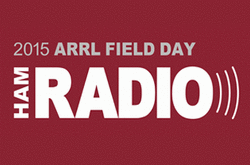Once again this year, a group of medium-wave experimental licensees will
transmit greetings on 630 meters during the ARRL Field Day weekend, June 27-28. While
the 472 to 479 kHz band is not yet available for Amateur Radio use, John
Langridge, KB5NJD, said he'd like to continue promoting awareness of the
proposed ham band. In  April, the FCC proposed a new 630 meter
Amateur Service MW allocation at 472 to 479 kHz, and it allocated a new LF
band, 135.7 to 137.8 kHz -- both on a secondary basis. Langridge this year is
hoping that some LF experimenters will also take part in the exercise. No
Amateur Radio operation will be permitted in either band until the FCC
establishes specific operating rules. Some of the stations involved in the
Field Day activity, including Langridge, are associated with the ARRL 600 Meter Experimental Group
(WD2XSH).
April, the FCC proposed a new 630 meter
Amateur Service MW allocation at 472 to 479 kHz, and it allocated a new LF
band, 135.7 to 137.8 kHz -- both on a secondary basis. Langridge this year is
hoping that some LF experimenters will also take part in the exercise. No
Amateur Radio operation will be permitted in either band until the FCC
establishes specific operating rules. Some of the stations involved in the
Field Day activity, including Langridge, are associated with the ARRL 600 Meter Experimental Group
(WD2XSH).
 April, the FCC proposed a new 630 meter
Amateur Service MW allocation at 472 to 479 kHz, and it allocated a new LF
band, 135.7 to 137.8 kHz -- both on a secondary basis. Langridge this year is
hoping that some LF experimenters will also take part in the exercise. No
Amateur Radio operation will be permitted in either band until the FCC
establishes specific operating rules. Some of the stations involved in the
Field Day activity, including Langridge, are associated with the ARRL 600 Meter Experimental Group
(WD2XSH).
April, the FCC proposed a new 630 meter
Amateur Service MW allocation at 472 to 479 kHz, and it allocated a new LF
band, 135.7 to 137.8 kHz -- both on a secondary basis. Langridge this year is
hoping that some LF experimenters will also take part in the exercise. No
Amateur Radio operation will be permitted in either band until the FCC
establishes specific operating rules. Some of the stations involved in the
Field Day activity, including Langridge, are associated with the ARRL 600 Meter Experimental Group
(WD2XSH).
ARRL 600 Meter Experiment (WD2XSH)
Coordinator Fritz Raab, W1FR, said that while the FCC's April Report and Order, Order, and Notice of Proposed Rulemaking is
a step in the right direction, it could be some time before hams have a
630 meter ham band in the US. "With that in mind," he told ARRL this week,
"we plan to renew the WD2XSH license and continue operations much as we have
been, until such time as the 630 meter band becomes a reality."
Langridge
said last year he got about 60 reports on his own transmissions from
Texas. "It seems the longer we do this, the more legs that grow on it, and
participation has really increased," he said. The point is to make active,
relevant signals available to existing Field Day stations that might have a
large pool of operators, many still having no idea that anything is going on
below the broadcast band."
Langridge said Field Day
stations could try using an HF transceiver capable of covering the 472-479 kHz
range to listen for participating stations. He stressed that stations can
use "whatever antennas that they have on site -- a dipole, a tribander, a
vertical, whatever -- as the impedance mismatch may help improve the
signal-to-noise ratio enough for effective copy."
Langridge said
that in 2014 he received an Argo screen shot of his CW signal from
Utah. "Reporting is important, since we all like to know who is listening
and how we are doing," he said. Stations hearing any of the MW (or possible
LW) Field Day "greeters" may report their reception online. Read more.